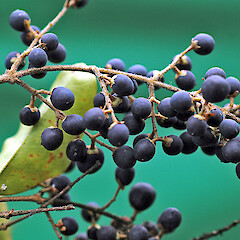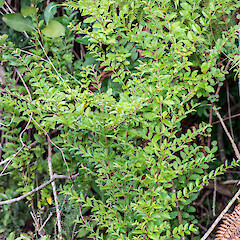Ligustrum sinense
Common name
Chinese privet
Family
Oleaceae
Flora category
Vascular – Exotic
Structural class
Trees & Shrubs - Dicotyledons
NVS code
The National Vegetation Survey (NVS) Databank is a physical archive and electronic databank containing records of over 94,000 vegetation survey plots - including data from over 19,000 permanent plots. NVS maintains a standard set of species code abbreviations that correspond to standard scientific plant names from the Ngä Tipu o Aotearoa - New Zealand Plants database.
LIGSIN
Conservation status
Not applicable
Habitat
Terrestrial. A plant of coastal and lowland habitats (Timmins & MacKenzie 1995). The plant occurs in sites of low-high fertility (Timmins & MacKenzie 1995). A plant of scrub and forest margin, roadsides, fencelines, open forest communities (Timmins & MacKenzie 1995). Communities in which the plant occurs are alluvial forest remnants, wasteplaces, shrublands, open stream systems and coastal areas (Department of Conservation 1996).
Wetland plant indicator status rating
Information derived from the revised national wetland plant list prepared to assist councils in delineating and monitoring wetlands (Clarkson et al., 2021 Manaaki Whenua – Landcare Research Contract Report LC3975 for Hawke’s Bay Regional Council). The national plant list categorises plants by the extent to which they are found in wetlands and not ‘drylands’. The indicator status ratings are OBL (obligate wetland), FACW (facultative wetland), FAC (facultative), FACU (facultative upland), and UPL (obligate upland). If you have suggestions for the Wetland Indicator Status Rating, please contact: [Enable JavaScript to view protected content]
FACU: Facultative Upland
Occasionally is a hydrophyte but usually occurs in uplands (non-wetlands).
Detailed description
Shrub or small tree to approx. 5m high, evergreen, or semi-deciduous in cold districts. Shoots densely hairy. Petioles to 5mm long, hairy. Lamina 2.5~6 x 1.25~2.5cm, elliptic or elliptic-oblong, dull green above, hairy on midrib beneath and usu. above in lower part, ciliolate when young; base broad-cuneate; apex usu. obtuse. Panicles to around 10cm long, rather loose; branches densely hairy, somewhat flattened, generally angular; pedicels short. Bracts and bracteoles linear to oblong, caducous. Flowers very fragrant. Calyx 1~2mm long, glabrous or nearly so; lobes very shallow. Corolla white; tube 1.5~2mm long, slightly > calyx; lobes about 3mm long, elliptic-ovate, spreading, subacute. Stamens = or slightly < corolla lobes; anthers pinkish-mauve or purple. Style exserted. Fruit 4~6mm diam., globose or subglobose, dull- or purplish-black. Seed 3~4mm long, oblong, shallowly grooved. (- Webb et. al., 1988)
Similar taxa
A shrub or small tree to 5 m high, evergreen or semi-deciduous with densely hairy shoots (Department of Conservation 1996). Leaf stalks are hairy, leaves are dull green above, hairy on the midrib below and oval (up to 6 cm) (Department of Conservation 1996). The plant has panicles of small white flowers (Department of Conservation 1996), fragrant (Anon., 1997: Pestfacts 49, ARC). The fruit is 6 mm in diameter and dull black (Department of Conservation 1996). It looks a bit like putaputaweta (Department of Conservation 1996).
Flowering
July, August, September, October, November, December, January, February, March
Flower colours
Violet/Purple, White
Life cycle
Perennial. The flower is bisexual; reproduces by seed (Timmins & MacKenzie 1995). Seeds may remain viable up to 6 months under 4dC refrigeration (ibid.). Gravity and vertebrates disperse seed (ibid.)
Year naturalised
1950
Origin
China
Reason for introduction
Ornamental
Tolerances
The plant is highly tolerant to shade; tolerant to drought; slightly tolerant to poor drainage (Timmins & MacKenzie 1995). The plant tolerates clay soil (Timmins & MacKenzie 1995). Requires low to high soil fertility (Atkinson 1997).
Poisonous plant
Poisonous purplish-black berries.













